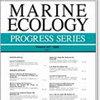时间和海洋因素对南加州白鲨聚集地两个大小等级的不同影响
IF 2.1
3区 环境科学与生态学
Q2 ECOLOGY
引用次数: 0
摘要
ABSTRACT: 包括鲨鱼在内的许多海洋物种的一个共同特征是,当它们的分布与人类资源开采和栖息地改造重叠时,就会面临保护威胁。例如,白鲨(Carcharodon carcharias)在幼年期表现出明显的沿海阶段,与成鲨的海盆范围相比,其分布范围有限。利用无人飞行器(UAV),我们研究了南加州港湾育苗区内的沿海聚集地,以确定细尺度的时间和海洋学因素如何影响处于不同发育阶段的白鲨。通过无人机测量的白鲨密度在一天中的不同时间和一年中的不同日期变化很大,不同年份的变化也不大。通常情况下,下午晚些时候观察到的鲨鱼较多。在海底温度较低的时期,鲨鱼,尤其是总长度为 3 米的鲨鱼,被观测到的次数更多,这可能反映了不耐寒的较小白鲨避开了这些较冷的深海水域。包含海面温度的替代模型显示,在我们调查的月份中,海面温度与总长度为3米的白鲨之间存在非常小但显著的联系,但与较大的白鲨之间没有这种联系。能见度、浪高、叶绿素含量、海况和潮汐高度对无人机观测到的鲨鱼密度没有影响或影响不大。了解密度的时间模式和海洋学预测因素如何随时间变化,以及鲨鱼的本体如何与这些因素相互作用,有助于我们更好地了解这一物种如何利用沿海栖息地,并预测它们何时更有可能与人类共享海洋空间。本文章由计算机程序翻译,如有差异,请以英文原文为准。
Temporal and oceanographic factors differentially affect two size classes of white shark at a Southern California aggregation site
ABSTRACT: Ontogenetic habitat shifts are a common feature of many marine species, including sharks, which face conservation threats when their distributions overlap with human resource extraction and habitat modification. White sharks Carcharodon carcharias, for example, exhibit a distinctly coastal phase as juveniles, with a limited distribution compared to the basin-scale range of adults. Using an unoccupied aerial vehicle (UAV), we studied a coastal aggregation site within a Southern California Bight nursery area to determine how fine-scale temporal and oceanographic factors affect white sharks at different developmental stages. White shark density, as measured via UAV, was highly variable across time of day and day of year, with modest variation across years. Typically, more sharks were observed in the late afternoon hours. Sharks, especially those <3 m total length, were observed more often during periods of colder seafloor temperatures, potentially reflecting avoidance of these colder, deeper waters by more cold-intolerant smaller white sharks. Alternate models incorporating sea surface temperature showed a very small but significant association between surface temperatures and <3 m total length white sharks for the months we surveyed, but no such association for larger sharks. There were no or only modest effects of visibility, swell height, chl a levels, sea state, and tidal height on UAV-observed shark density. Understanding how temporal patterns and oceanographic predictors of density change over time as well as how shark ontogeny interacts with these factors can help us to better understand how this species uses coastal habitats and predict when they may be more likely to share marine space with humans.
求助全文
通过发布文献求助,成功后即可免费获取论文全文。
去求助
来源期刊

Marine Ecology Progress Series
环境科学-海洋学
CiteScore
5.30
自引率
8.00%
发文量
238
审稿时长
3 months
期刊介绍:
The leading journal in its field, MEPS covers all aspects of marine ecology, fundamental and applied. Topics covered include microbiology, botany, zoology, ecosystem research, biological oceanography, ecological aspects of fisheries and aquaculture, pollution, environmental protection, conservation, and resource management.
 求助内容:
求助内容: 应助结果提醒方式:
应助结果提醒方式:


